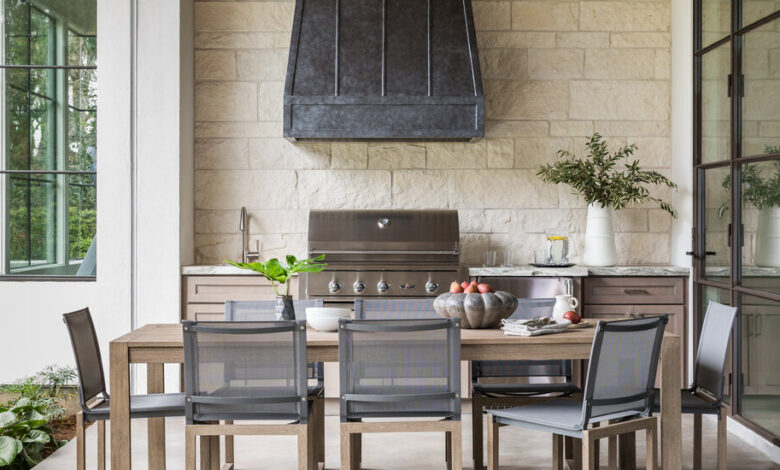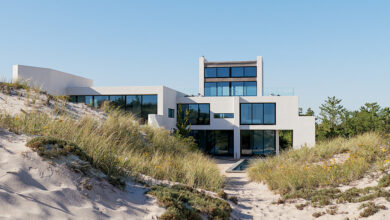How to Create an Outdoor Kitchen

One of the great pleasures of summer is grilling food outside, over an open flame. If you’re fortunate enough to have some space outdoors, your grill can become more than just a place to flip burgers. With a little design help, you can turn it into an outdoor kitchen — and the center of all your outdoor entertaining.
“I look at the outdoor kitchen as an extension of the great room,” said Allison Babcock, an interior designer in Sag Harbor, N.Y., who frequently designs outdoor kitchens. “It’s not just a barbecue space; it’s about moving a whole lifestyle outside.”
Just as the indoor kitchen has expanded to become a hub for many homes, the outdoor kitchen is having its day in the sun thanks to improvements in materials and equipment, and aesthetic upgrades.
“An outdoor kitchen can serve as a beautiful focal point,” said Marie Flanigan, an interior designer based in Houston, who includes an outdoor kitchen with nearly every home she designs. “Inside, people always gravitate toward the kitchen, and I think the outdoor kitchen can also become the heart of the outdoor space.”
We asked Ms. Babcock, Ms. Flanigan and other designers for advice on how to get started.
Choose the Location
While it may be tempting to choose a distant, unused corner of a big yard or terrace as the place to put your outdoor kitchen, it usually isn’t the best choice.
“A lot of people will say, ‘Oh, I never use the back of my yard, so put the kitchen there, so I’ll go back there and use it,’” said Jesse Terzi, the principal of New Eco, a landscape design firm in Brooklyn, N.Y. “But that never happens. I always tell people to try to put it as close to the house as possible. Because the closer it is, the more you’ll use it.”
That’s true in all seasons, Mr. Terzi said. Even in the winter, when it’s too cold to sit outside, if your grill is just beyond the patio slider, you may decide to fire it up for the occasional dinner. Carrying utensils, platters and condiments from the indoor kitchen to the outdoor one will also be easier.
It also makes it easier — and less expensive — to run services like electricity, plumbing and gas from your home to your outdoor kitchen. “If you’re wanting to install a sink all the way across the yard, but don’t have plumbing there, that just drives your costs up exponentially,” said Michael Calacino, a designer at RTA Outdoor Living, a manufacturer of outdoor kitchens. “But if you do it against the house, you can tie into your existing water.”
Just don’t put it too close to the house. Any grills and other flame-generating appliances should be kept away from combustible materials, and you should always follow manufacturers’ recommendations and local regulations. In New York, for instance, grills must be at least 10 feet away from any material that could burn, like wood siding.
Select Your Equipment
As interest in outdoor kitchens has grown, so has the range of available appliances. Beyond grills, there are smokers, pizza ovens, burners, refrigerators, ice makers and beverage centers, to name a few popular options.
How many of those things do you really need? The truth is, you can create an impressive outdoor kitchen with a limited number of appliances. For a small outdoor space, a single cooking appliance is sometimes best. The obvious choice is a grill, Mr. Calacino said, but before you spend any money, consult your inner chef.
“I’ve worked with folks who love grilling,” he said. “But I’ve also worked with folks where all they want is a power burner, because they want to do wok cooking outside.”
After you choose the appliances, what’s next? A counter. Having counter space near the cooking area can make a huge difference in the way an outdoor kitchen functions.
“Countertop space is great for prep,” said Michael D’Angelo, a landscape architect in Boston. It offers a place to put platters, trays, tools and ingredients; it provides a place to work; and it helps with presentation when the food is ready to serve.
“If you’re hosting an event with family or friends,” Mr. D’Angelo said, “you can set it up as a serving counter, for buffet-style dining.”
Cabinets installed below the counters are also useful for stashing grilling tools, a trash bin and other accessories right where you need them.
Choose Robust Materials
Outdoor kitchens can take a beating from the elements, and if they’re not made from the right materials, they can deteriorate rapidly. Quality outdoor appliances are designed to withstand storms; cabinets and counters should be, too.
Wood cabinets should be built with a framework of weather-resistant wood or metal and clad in a resilient hardwood like ipe, teak or mahogany, Mr. D’Angelo said. At New Eco, Mr. Terzi said he often uses composite decking for cabinetry cladding (including products made by Trex and TimberTech) because it requires less maintenance (like regular oiling) and tends to last longer than wood.
Mr. D’Angelo also likes cabinets from Urban Bonfire, made from marine-grade aluminum. RTA Outdoor Living makes cabinets from a concrete composite. And Ms. Flanigan has designed custom cabinets clad in stone veneer, painted brick and stucco.
“I like reusing materials that are already being used on the exterior of the house,” Ms. Flanigan said. That’s good for durability, and it also “helps the kitchen feel embedded into the architecture.”
Choosing a countertop material is trickier outdoors than indoors. Anything that can be easily stained, like marble, should be ruled out, unless you want a rustic look. With marble, “not only can food stain it, but you’re going to have to worry about oak pollen and leaves staining it,” Mr. D’Angelo said. Granite, bluestone and soapstone are all good options, he said, as are quartz products designed specifically for outdoor use.
Include Seating Areas
Few grill masters want to grill alone, and guests are likely to congregate around the chef, so it’s a good idea to include a seating area.
When designing an outdoor space south of Los Angeles, Mindy Gayer, a designer based in Costa Mesa, Calif., installed three seating options near the grill: a bar at a pass-through window between the indoor and outdoor kitchens; a casual dining table with benches; and a cushy sectional sofa.
“We approached designing it in the same way we would approach an indoor kitchen,” Ms. Gayer said. “We wanted to make it really comfortable for the family to hang out.”
To create a showstopping outdoor room, Ms. Gayer also designed a brick fireplace beside the grill, as a focal point. And for a sink with character, she built a washing station against the house that’s as chic as any powder-room vanity, with a weathered limestone trough as the basin and a custom faucet made from copper plumbing pipe.
“We almost approached it backward,” she said, by thinking about lounge space first and the appliances second. “That made it an opportunity to have a more aesthetic outdoor kitchen.”
Add Creature Comforts
To maximize the time you can spend enjoying your outdoor kitchen, add a few key accessories. Start with lighting, which is crucial if you want to see your skewers on the grill after dusk.
Some higher-end grills have built-in interior lighting. Mr. Terzi and Mr. D’Angelo like to install sconces on nearby walls and fences to illuminate counters.
Do you have a roof overhang? That’s an opportunity for a pendant lamp. If you don’t have a place to install hard-wired lighting, Ms. Babcock recommends using hurricane lanterns or portable, rechargeable LED fixtures.
Infrared heaters are another nice touch that can extend the outdoor cooking season, Ms. Babcock said. They can be tucked into the ceiling of an overhang or pergola for a minimally intrusive look. Some manufacturers, like Heatsail, are also integrating a heating function into outdoor lamps.
Outdoor speakers can help set the mood, Mr. D’Angelo said, whether you’re having a relaxed dinner or a raucous barbecue.
Finally, “ceiling fans are great to have outdoors,” he suggested, noting that a cooling breeze is always welcome, and so is their other, more important function: “They keep the bugs down.”
For weekly email updates on residential real estate news, sign up here.
Source link






